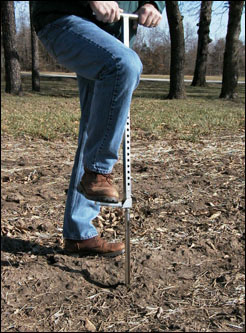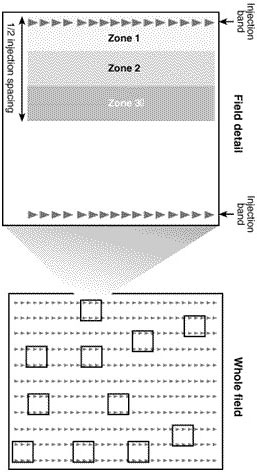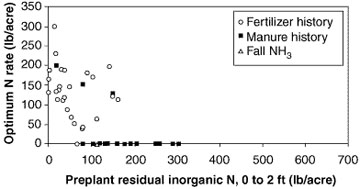Overapplication of fertilizer or manure nitrogen (N) in corn can cause water quality problems when unused nitrogen leaches into ground and surface water. Applying nitrogen according to crop need maximizes the economic benefits of applying fertilizer.
As a supplement to the standard soil test, a preplant N test measures the fertilizer value of inorganic N (nitrate N + ammonium N) in the soil. It requires sampling the soil to a depth of two feet. By measuring the amount of inorganic N in the soil profile, you can adjust fertilizer N to avoid over- or underfertilization.
Use the preplant N test on cornfields in spring where significant inorganic N is expected. The test is recommended in springtime in the following situations:
- On fields that have received manure anytime since the previous summer.
- On fields that have a history of heavy manure applications.
- Following a drought year on fields with a high potential for carryover of fertilizer N.
- Following fall and early-spring fertilizer applications where excessive rainfall may have caused losses of fertilizer N.
The preplant N test is not recommended under typical weather conditions on cornfields receiving all nitrogen as spring applied fertilizer.
What is inorganic N?
Crops take nitrogen from the soil as nitrate N(NO3-N) and ammonium N (NH4-N). Most nitrogen fertilizers are applied as either nitrate or ammonium, or both, or are rapidly converted to these forms of N in the soil. Another term used to describe the total content of nitrate N + ammonium N in a sample is inorganic N (nitrate N + ammonium N = inorganic N). The preplant N test measures inorganic N in the soil and detemines its fertilizer value to the crop.
How to take a preplant N soil sample
The best time to sample the soil for the preplant N test is one to three weeks before you anticipate applying spring fertilizer. Divide fields into subfields for sampling when soil conditions or previous management make it likely that levels of soil inorganic N may differ within the field. The test requires sampling the soil to a depth of two feet. Using a soil sampling probe or coring device (Figure 1), obtain 15 to 20 two-foot-long cores for each field or subfield. See the box below on how to sample fields after banded applications such as injected anhydrous ammonia or manure.
 Figure 1
Figure 1
Use a soil sampler to obtain a 2-foot soil core.
Crumble the cores into small pieces and mix the soil thoroughly in a bucket. A coarse screen may be needed to help crumble the soil cores into small pieces on fields with high clay content. Place a subsample into a plastic bag or soil sampling box. Clearly label the sample with the field identification and submit the sample immediately to the soil testing laboratory. If you cannot submit the sample the day of sampling, freeze or refrigerate the samples or air dry them the day of sampling by spreading them out on a flat surface. Subsamples left in warm conditions will undergo changes that result in errors in the N fertilizer recommendation.
 Figure 2
Figure 2
Sampling method.
How to sample banded fields
On fields where the location of injection bands for fertilizer or manure N is known, the objective is to take 30 cores using the following method:
- At a randomly selected point in the field, take three 2-foot cores, one from each of three zones adjacent to an injection band (Figure below).
- Repeat the procedure at 10 or more randomly selected locations in the field.
Take the cores at various points in each zone as you move among sampling sites in the field.
On fields where the location of the N bands is not known, take at least 30 cores, randomly scattered over the field.
Without a sampling method like this, the tendency is to take too many cores over the injection point on fields with banded manure or fertilizer N. This causes an overestimate of the value of inorganic N in the soil, resulting in a recommendation that will leave corn short of N.
Submitting samples to the soil testing laboratory
When you submit the sample, you will need to provide the following information: the reason for sampling, date of sampling, crop to be grown, and the rate of fertilizer N recommended for the field. The recommended rate should reflect the full amount of nitrogen needed for the crop and not be reduced for any manure or fertilizer nitrogen already applied. Supplying this information will allow a more complete recommendation. Be sure to request the UMC Soil N test with recommendation on the laboratory form. Lab cost for the test is $7. Submit samples to your local MU Extension center or to the following address:
- MU Soil and Plant Testing Laboratory
23 Mumford Hall
Columbia, Mo. 65211
http://soilplantlab.missouri.edu/soil
Interpreting the preplant N soil test for cornfields
The preplant N test estimates the fertilizer value of inorganic N in the soil immediately before planting. The test results are reported in pounds of nitrogen per acre. Reduce the fertilizer N rate recommended in your routine soil test by the amount of "credit" determined in the preplant N test (Equation 1):
Equation 1
Additional corn pounds N per acre needed = fertilizer N recommendation - preplant N test credit
If the results from Equation 1 are 0 or negative, no additional nitrogen needs to be applied to the field; the soil contains sufficient nitrogen to make a full crop. Do not be alarmed if the result of Equation 1 is negative; a negative result means more nitrogen is available in the soil than what the corn crop will need and no additional fertilizer N should be applied.
If you submit the corn fertilizer recommendation for the field along with your preplant N soil sample, the lab will provide an N recommendation. The soil test report will also show the nitrate N and ammonium N levels in the soil in parts per million (ppm). Disregard this information when calculating the need for additional nitrogen for corn.
Example 1
You submit a preplant N test sample taken March 30 for a field that received 150 pounds N per acre as anhydrous ammonia the previous October. The N recommendation for that corn crop is 150 pounds N per acre. The preplant test N credit = 100 pounds N per acre.
Additional nitrogen needed = 150 pounds N per acre - 100 pounds N per acre = 50 pounds per acre
The test recommends applying an additional 50 pounds N per acre. There has apparently been some loss of the fall-applied N fertilizer over the winter. The test benefits you in this situation by reducing the potential for yield loss from lack of fertilizer N.
Example 2
You submit a preplant soil test sample taken April 5 from a field that was in corn last year and will be in corn again this year. Through July and August of the previous year, drought conditions substantially reduced yields. The winter has had below average precipitation. Your routine soil test for the field recommended 135 pounds N per acre. The preplant N test credit = 65 pounds N per acre.
Additional nitrogen needed = 135 pounds N per acre - 65 pounds N per acre = 70 pounds N per acre
The test recommends applying 70 pounds N per acre. The dry weather of the previous growing season has resulted in unused nitrogen in the soil. This nitrogen has not leached and is available for the coming year's crop. You will save money by safely reducing spring nitrogen rates. If fertilizer costs $0.17 per pound you save $11.05 per acre.
Incorporating the preplant N test into a manure management plan
The preplant N test can provide valuable information about the availability of nitrogen from manure to a corn crop. The following two scenarios describe appropriate ways to incorporate the preplant N test into a manure management plan.
Fields after a spring or fall application of manure
The preplant N test is used to confirm the availability of spring- or fall-applied manure N to the corn crop. Many factors can dramatically affect how much manure N is available to the corn crop:
- Cool or dry weather can reduce the release of organic N from the manure.
- Weather conditions can create greater than predicted losses of ammonia N from surface applications.
- Excessively wet conditions in late spring can cause losses of manure N by denitrification.
The preplant N test determines whether additional manure or fertilizer N is needed to meet the nitrogen needs of a corn crop.
The soil sample should be taken in the spring before planting, at least five days after manure has been applied to the field. The test may underestimate manure contributions from spring-applied solid manure (like poultry litter) if the test is taken soon after manure application. It may overestimate manure contributions if the test is taken within a week of a surface application of liquid manure.
Use manure testing to determine the initial manure application rate. If you are confident that manure N is available to the crop, the preplant N test may not be necessary. The test is most applicable where there are concerns about the ability of nitrogen from manure to meet corn N need completely.
An alternative manure application strategy is to use book values to determine a manure application rate that will provide somewhat less manure N than the corn crop will need. Use the preplant N test after manure application to determine the amount of additional nitrogen the crop will need from manure or fertilizer.
Fields with a history of heavy manure applications
Use the preplant N test before applying more manure or fertilizer on fields with a multiple-year history of repeated manure applications. The preplant N test will determine the value of the residual nitrogen to the corn crop.
Example 3
You submit a preplant N test sample taken April 15 for a field that received 2 acre-inches of surface-applied lagoon effluent between April 1 and April 5. Manure tests suggested the applied manure provided 175 pounds of fertilizer N per acre. The recommendation for corn was 175 pounds N per acre. The preplant N test credit is 125 pounds N per acre.
Additional nitrogen needed = 175 pounds N per acre - 125 pounds N per acre = 50 pounds N per acre
The test recommends applying 50 pounds N per acre. The manure test provided a rough estimate of how much lagoon effluent to apply, but the preplant test implies that the actual fertilizer value of the manure was less than expected.
Example 4
On a field that has a long history of manure applications in previous years, you submit a preplant soil test sample taken on March 15. The recommendation for corn was 150 pounds N per acre. The preplant N test credit was 250 pounds N per acre.
Additional nitrogen needed = 150 pounds N per acre - 250 pounds N per acre = 1,100 pounds N per acre
Because the result is negative, the preplant test suggests no additional nitrogen is required on this field. Apparently the residual nitrogen from manure will provide sufficient nitrogen for this corn crop. Before planting corn again next year on this field, plan on using the preplant nitrogen test again.
Using the soil N test for other crops
The preplant soil N test can be used with other spring-seeded grain crops. For example, the test could be used as described for corn to adjust sorghum nitrogen recommendations.
The soil N test and resulting credit can also be used to adjust spring nitrogen recommendations for wheat. Take the test before applying spring fertilizer to wheat if manure has been applied or if previously applied fertilizer may have been unused due to drought. Your total (fall + spring) N rate recommendation must be reported on the sample form to get a correct recommendation for spring nitrogen needed.
How the test was developed
The preplant N test was evaluated in 48 experiments on Missouri farms from 1995 to 1998; at 19 of these locations, manure had been applied within the past year. The test was evaluated on cornfields following soybean, wheat and corn crops and in tilled and no-till fields.
Research at these locations demonstrated that sites with high inorganic N in the soil did not respond to fertilizer (Figure 3).

Figure 3
Sites with high residual nitrogen in the soil do not need additional fertilizer.
The preplant N test uses the following equations to estimate the fertilizer value of inorganic soil N:
Fields with manure history or fall-applied N
Preplant N test credit (pounds per acre) = (nitrate N + ammonium N)(0-2 feet) - 50
Where nitrate N + ammonium N is measured in pounds per acre. A negative result is set to 0. This interpretation of the preplant N test gave the highest returns on fertilizer N applications on manured fields.
Using the preplant N test to improve corn N recommendations on fields with a history of manure applications improved returns from fertilizer N by more than $7 per acre when compared with using a manure crediting system.
Fields with residual nitrogen from previous year's crop
Preplant N test credit (pounds per acre) = (nitrate N)(0-2 feet) - 50
Where nitrate N is measured in pounds per acre. A negative result is set to 0.
Summary
The preplant N test provides a way for Missouri farmers to measure the residual or manure N in the soil and determine its value to a corn crop.
- This spring nitrogen test determines the fertilizer value of inorganic N in the soil.
- It is best used
- on fields that have received manure anytime since the previous summer.
- on fields that have a history of heavy manure applications.
- following a drought year on fields with a high potential for carry over for fertilizer N.
- following fall and early spring fertilizer applications where excessive rainfall may have caused losses of fertilizer N.
- The test is not recommended unless there is an expectation of elevated nitrogen in the soil profile.
- Take at least 15 two-foot cores from each field (30 cores if applied N or manure was injected in bands).
- Submit the soil samples to the lab the day of sampling; otherwise the samples must be refrigerated, frozen or air dried before they are submitted.
- Test results are reported as pounds of fertilizer N per acre. Subtract the test result from the fertilizer N recommendation obtained in a routine soil test to determine the additional fertilizer N need of corn.